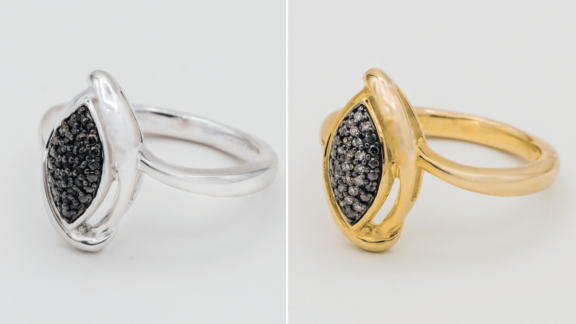What Metals Can I Gold Plate?
Written by Annabelle
June 21, 2019

Gold electroplating is one of the most popular jewelry services; after all, the ability to just “dip” an item in gold and make it beautiful is wonderfully appealing. But before you blithely dump your item into a box and ship it off for gold plating, you should do your research. Not all metals are created equal, and not all jewelers will blindly plate whatever you send them.
How does gold electroplating work?
Gold electroplating is the process of putting an item into a plating tank and running electricity through the water to chemically fuse gold particles to the surface of that item. Imagine a big sink of water; except that in this case, the “water” is actually a solution of gold cyanide. The reaction caused by the electricity causes the gold to “deposit” onto the item, which also needs to be made out of a material that can conduct electricity. As a result, if you're plating jewelry that has gems in it, the gems will be unaffected by the gold plating process. However, the surrounding metal will turn a bright and gleaming color.
What metals can I plate?
Technically, while all metals can be plated, jewelers will refuse to plate some items for various reasons. The most common reason is due to the fact that exposure to certain metals will cross-contaminate the plating tanks. For instance, if a tank is used for fine metals, a strange base metal such as an unknown cheap alloy or a piece of zinc may disturb the chemical makeup within that tank. As a result, it's very difficult to find someone willing to plate costume jewelry.
Precious Metals
- Silver – Silver is one of the best metals to plate. Any jeweler with a plating tank will take silver; it's a common precious metal and it doesn't cause any complications in the plating process. As with all metals, it will be thoroughly polished and cleaned before plating, as any imperfections in the surface will show through the layer of gold.

A sterling silver ring before and after gold plating
- White Gold – White gold is typically plated with rhodium, a strong silvery white substance. Nevertheless, it can be electroplated with yellow gold without any fuss due to its chemical makeup.
Base Metals
- Brass – Brass is a base metal, or a metal that is not considered precious. Because of its composition, brass will diffuse through gold plating if there is no preliminary layer between the gold and brass. Jewelers who properly plate brass will polish it, coat it in either nickel or palladium as a barrier, and then gold plate it to prevent any issues.

A set of brass bracelets before and after gold plating.
- Copper – Copper is one of the more difficult metals to gold plate. It oxides very quickly, developing a darkened exterior. This oxidation is so strong that it can seep right through gold plating, causing an ugly discoloration. As with brass, it needs to be plated with a preliminary coating of palladium in order to extend the “life” of the plating. However, the copper will show through eventually, as the palladium only slows down the oxidation process.

A copper necklace before and after plating.
- Pewter – As with brass and copper, pewter requires a layer of nickel as a coating before it is gold electroplated. The texture of pewter may often show through gold plating, since many pewter pieces have a distinct matte or antique finish.
- Bronze – Bronze is an alloy that consists of mostly copper. Due to this, it also has a tendency to oxide and/or diffuse into plating, causing jewelers to give it a preliminary coating.

A bronze ring before polishing and plating.
- Zinc, Aluminum, and Titanium – These metals and their various alloys are normally found in cheap costume jewelry, usually manufactured overseas. Like the other base metals, they need a layer of nickel before gold electroplating. However, it's even harder to find someone willing to plate them in comparison to other base metals such as brass, copper, pewter, and bronze. This is because these metals are rarely worked with in the jewelry industry after the initial production in China or India.

This costume pendant is made from a strange alloy; it was once gold-plated but the color has worn off to reveal the nickel plating below.
Now that you're up to date on what metals can be gold-plated (and how complicated it is!), take some time to touch up your jewelry. Whether it's a costume piece with sentimental value, or a silver item that you're not too fond of in terms of color, check out our gold electroplating service below.



